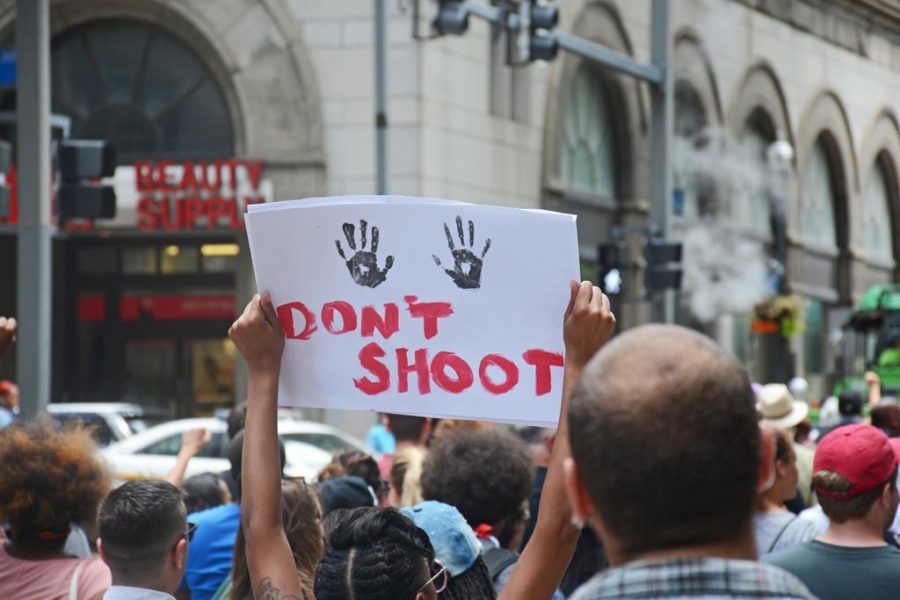To first-time organizer Sarafina Davis, Saturday’s Black Lives Matter protest was about one thing: The death of people who look like her.
“Our black men are being killed on these streets and there is no accountability,” Davis, a Pittsburgh resident, said.
Spreading fast through social media, Saturday’s demonstration started at Point State Park, where two separate groups gathered before meeting under the I-279 overpass. The protesters then made a loop through Downtown, along Liberty Avenue, Sixth Street, Grant Street and Fort Pitt Boulevard before returning to Point State Park. The march, coming after a week of carnage, lasted nearly three hours.
Police placed the number of protestors between 1,200 and 1,300 strong at its peak on Sixth Avenue.
Davis had never been involved in activism before this weekend but was drawn in because of concern for her children.
“[I realized] that could be my kid,” Davis said, referring to deaths like that of Alton Sterling and Philando Castile.
Early Tuesday morning, Sterling was killed during a police confrontation in Baton Rouge, Louisiana, in a parking lot where he sold homemade CDs. On Wednesday, Castile, a school cafeteria supervisor, was killed during a traffic stop in St. Paul, Minnesota. Both deaths were filmed and went viral on social media.
An otherwise peaceful protest of hundreds of people in downtown Dallas Thursday night turned violent when 25-year-old Micah Johnson shot police officers, killing five and injuring seven.
At Pittsburgh’s protest, concern for the next generations inspired activist Rod Adams, from Minneapolis, who was in town for the People’s Convention, a weekend gathering of more than 1,500 people from community organizations across the country to discuss confronting social issues such as immigration and economic inequality.
“They are not only killing us, they are killing our future,” Adams said.
After two groups of protesters combined in Point State Park, they marched up Liberty Avenue before hooking onto Sixth Avenue.
Adams was out in front of the demonstration for the majority of the march, which swelled in numbers as it moved through Downtown.
“People were coming out of their businesses and taking off their aprons [to join the march],” Adams said.
The protesters stopped outside the Port Authority Building for 10 minutes to protest the January killing of Bruce Kelley Jr. in Wilkinsburg. Port Authority police shot and killed Kelley, who was black, after he stabbed and killed a police dog. After a five-month review that ended in June, the Allegheny County District Attorney Stephen Zappala found the two officers were justified in their use of force.
But Kelley’s case still makes Juliandra Jones, a Pittsburgh resident, concerned about police conduct with black people.
“We need to better train police officers in how to handle situations with minorities,” Jones said. By protesting, she hoped “the government would properly look at its policies.”
While Kelley was armed, reporting by The Guardian has shown that black people are more likely to be killed by police than white people regardless of situation, with 7.13 black people killed per million people, compared to 2.91 white people killed per million.
On Sixth Street, the protest erupted in an optimistic rendition of the chorus from Kendrick Lamar’s “Alright” several times, but most chants expressed deep frustration. Protesters — and the occasional bystander — joined in chants of “the whole damn system is guilty as hell” and “if we don’t get [justice] then shut it down” throughout the march.
The protest itself cooperated with city police throughout the day. After walking down Sixth Avenue — with a stop in front of Allegheny County Courthouse — protesters hoped to march onto I-376. But a police barricade — which including some officers in tactical gear — stood in the way.
A call went out for parents to take their kids home, and protesters locked arms and marched towards the entrance to the parkway.
The police line did not budge, and leaders huddled with police officers as the crowd chanted slogans. After 10 minutes of conversation, the protest’s leaders announced the police’s intention to arrest anyone who entered the parkway. Instead, the protesters turned onto Fort Pitt Boulevard and marched back to Point State Park.
There, numerous speakers, including Adams, Davis and Brandi Fisher, another Pittsburgh activist, took to a previously set-up stage to engage the dwindled crowd, which police said was 400 to 500 people, for an hour.
Some made use of spoken word poetry when presenting their point. Despite differences in presentation, they all coalesced around one point — their struggle would be a long one requiring constant action.
“Every time a body hits the ground that looks like my brother or sister, I will be out in the streets,” Adams said. He pressed others to make the same commitment.
Fisher, who is president of the Alliance for Police Accountability, made reference to Thursday night’s shooting in Dallas.
“What the Dallas shooting shows us is that if there is no accountability, there is no justice, there is no peace,” Fisher said, harkening back to the much-used chant “No justice, no peace”.
After the speeches, protesters dispersed from the park. The protest was peaceful, with no arrests or citations reported. Adams was impressed by the turnout produced by a Facebook event and thought it showed the precarious state of the nation.
“This is amazing,” Adams, who protested in Ferguson, Missouri, said. “[But] it shows you the moment we are in in this country.”



